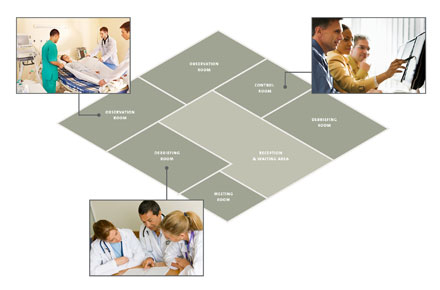医者と患者のインタラクション
医者と患者の間のコミュニケーションは、医療における重要な要因です。実験トライアルは通常、ラボで行われますが、これは常設施設でもそうでなくてもかまいません。例えば、病院でのチームワーク行動はしばしば病院や養護施設で研究されます。 時々は、家庭でも介護者と患者との相互作用を観察します。すべての設定で(しばしばVisoを使用)で、ビヘイビアが記録され、その後The Observer XTで分析されます。

マルチルーム、マルチビデオ録画
Visoは、コンサルティングや医療シミュレーション室に最適なセットアップを作成し、ライブまたは直後にレコーディングを表示することができます。Visoを使用すると、各部屋のオーディオを含め、最大4台のIPカメラから一度に同期録画を作成できます。ある場所(中央の部屋)から録画を簡単に管理し、各部屋に最大4台のカメラを備えた任意の数の部屋に録画できます。
ビヘイビアを観察し、パフォーマンスを評価する
診察室に入るときに患者が不安を感じることがあります。 研究者は、生理学的データストリームをビデオと一緒に監視し、行動コンテキストにおける患者の感情を評価します。The Observer XTは、すべてのデータを同期、保持するために使用されます。 このソフトウェアツールは、特に、ビデオや生理学的信号などの複数のモダリティを同期して記録および再生するように設計されており、非言語的および口頭的な振る舞いは、The Observer XTでコーディングすることができます。会話を書き換え、この情報を、例えば看護師と患者の行動と組み合わせます。
表情分析
FaceReaderは、通信研究、心理学、教育研究、消費者調査など、400以上の大学、研究機関、および多くの市場の企業で世界中で使用されています。
コンサルティングサービス
また、高品質のサービスを提供する行動コンサルタントへの依頼もできます。彼らは非常に知識が豊富で、経験豊富で、実験をサポートする準備ができています。 ビデオ素材、観測サービス、またはその他のコンサルティングサービスのコーディングについてもサポートいたします。コンサルティングサービス、 トレーニングコースやレンタルサービスについては、お問い合わせください。

出版物
- Asan, O.; Smith, P.D.; Montague, E. (2014). More screen time, less face time ? implications for EHR design. Journal of Evaluation in Clinical Practice. doi:10.1111/jep.12182
- Asan, O.; Montague, E. (2012). Physician interactions with electronic health records in primary care. Health Systems, 1-8, doi:10.1057/hs.2012.11.
- Albada, A.; Ausems, M.G.E.M.; Dulmen, van S. (2014). Counselee participation in follow-up cancer genetic counselling visits and associations with achievement of the preferred role, cognitive outcomes, risk perception alignment and perceived personal control. Social Science & Medicine, 178-186.
- Albada, A.; Dulmen, S. van; Ausems, M.G.E.M.; Benzing, J.M. (2012). A pre-visit website with question prompt sheet for counselees facilitates communication in the first consultation for breast cancer genetic counseling: findings from a randomized controlled trial. Genetics in Medicine, 14 (5), 535-542.
- Boehmer, K.R.; Egginton, J.S.; Branda, M.E.; Kryworuchko, J.; Bodde, A.; Montori, V.M.; LeBlanc, A. (2014). Missed opporunity? Caregiver participation in the clinical encounter. A videographic analysis. Patient Education and Counseling, 96, 302-307.
- Cruz, J.; Marques, A.; Barbosa, A.; Figueiredo, D.; Sousa, L.X. (2013). Making sense(s) in dementia: a multisensory and motor-based group activity program. Journal of Alzheimer’s Disease and other Dementias, DOI: 10.1177/1533317512473194.
- Figueiredo, D.; Barbosa, A.; Cruz, J.; Marques, A.; Sousa, L. (2013). Empowering staff in dementia long-term care: towards a more supportive approach to interventions. Educational Gerontology, 39 (6), 413-427.
- Noordman, J.; Vet, E. de; Weijden, T. van der; Dulmen, S. van (2013). Motivational interviewing within the different stages of change: An analysis of practice nurse-patient consultations aimed at promoting a healthier lifestyle. Social Science & Medicine, 87, 60-67.
- Sep, M.S.C.; Osch, M. van; Vliet, L.M. van; Smets, E.M.A.; Benzing, J.M. (2014). The power of clinicians’ affective communication: How reassurance about non-abandonment can reduce patients’ physiological arousal and increase information recall in bad news consultations. An experimental study using analogue patients. Patient Education and Counseling, 1, 45-52, http://dx.doi.org/10.1016/j.pec.2013.12.022
- Slort, W.; Blankenstein, A.H.; Schweitzer, B.P.M.; Deliens, L.; Horst, van der, H.E. (2014). Effectiveness of the ‘availability, current issues and anticipantion’ (ACA) training programme for general practice trainees on communication with palliative care patients: A controlled trial. Patient Education and Counseling, 1, 83-90.
- Spelten, E.R.; Martin, L.; Gitsels, J.T.; Pereboom, M.T.R.; Hutton, E.K.; Dulmen, van S. (2014). Introducing video recording in primary care midwifery for research purposes: Procedure, dataset, and use. Midwifery, doi: 10-1016/j.midw.2014.06.007.
- Zhou, Y.; Cameron, E.; Forbes, G.; Humphris, G. (2012). Development of a novel coding scheme (SABICS) to record nurse-child interactive behaviours in community dental preventive intervention. Patient Education and Counseling.




